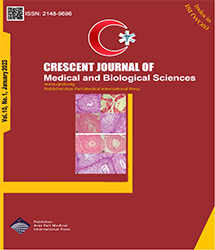| Original Article | |
| Explanation of the Concept of Wet Liver Dystemperament (sue-mizaj) in Iranian Traditional Medicine (Persian medicine): A Hybrid Concept Analysis | |
| Fatemeh Hakimi1, Farideh Yaghmaei2, Abbas Alipour3, Majid Asghari4, Hasan Namdar5, Parisa Jafari6, Mina Movahhed7 | |
| 1Clinical Research Development Unit, Moradi Hospital, Rafsanjan University of Medical Sciences, Rafsanjan, Iran 2Department of Nursing, Zanjan Branch, Islamic Azad University, Zanjan, Iran 3Department of Health and Social Medicine, Mazandaran University of Medical Sciences (MAZUMS), Mazandaran, Iran 4Traditional Medicine Research Center, School of Traditional Medicine, Qom University of Medical Sciences, Qom, Iran 5Department of Traditional Medicine, School of traditional medicine, Shahed University of Medical Sciences, Tehran, Iran 6Department of Persian Medicine, School of Medicine, Zanjan University of Medical Sciences, Zanjan, Iran 7Traditional Medicine and Materia Medica Research Center, Shahid Beheshti University of Medical Sciences, Tehran, Iran |
|
|
CJMB 2023; 10: 020-026 DOI: 10.34172/cjmb.2023.04 Viewed : 2752 times Downloaded : 3727 times. Keywords : Dystemperament, Liver, Concept Analysis, Hybrid Model, Iranian Traditional Medicine, Persian Medicine |
|
| Full Text(PDF) | Related Articles | |
| Abstract | |
Objectives: The semiology of liver dystemperament can help in predicting susceptibility to some diseases and improving the treatment process of the liver or general disease such as non-alcoholic fatty liver disease (NAFLD). Therefore, the aim of this study was to explain the wet liver dystemperament concept in Iranian traditional medicine (ITM) based on a hybrid concept analysis. Materials and Methods: The literature review of this qualitative study focused on evaluating 11 major academic textbooks from the 3rd to 19th century and some databases. In-depth, semi-structured, and face-to-face interviews were conducted with 16 ITM experts with a minimum of five years of clinical experience and maximum variations in terms of gender, age, and clinical experiences for empirical data gathering. Data were analyzed with MAXQAD10 and conventional content analysis. Results: In this study, wet liver dystemperament was classified into three main themes of systemic, local, and Para-clinical symptoms and 10 categories. Conclusions: This manuscript explains wet liver dystemperament as a disorder in general temperament and determines more important diagnostic criteria. |
Cite By, Google Scholar
Google Scholar
PubMed
Online Submission System
 CJMB ENDNOTE ® Style
CJMB ENDNOTE ® Style
 Tutorials
Tutorials
 Publication Charge
Women's Reproductive Health Research Center
About Journal
Publication Charge
Women's Reproductive Health Research Center
About Journal
Aras Part Medical International Press Editor-in-Chief
Arash Khaki
Deputy Editor
Zafer Akan





























